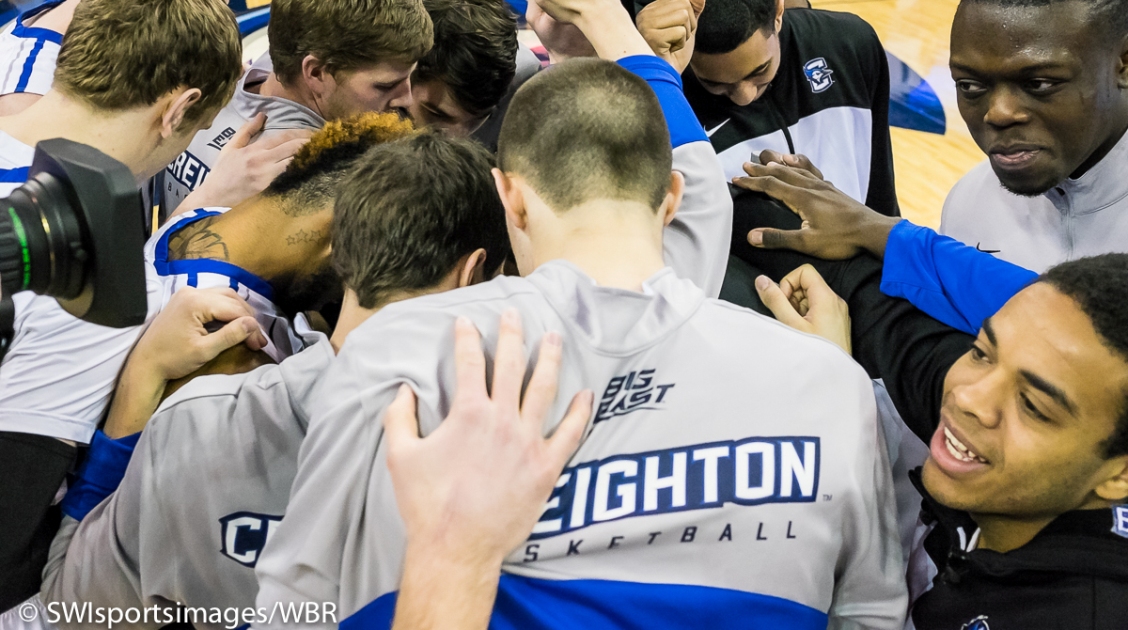After being proposed last month by the NCAA Rules Committee, a litany of rules changes were formally adopted on Monday aimed at increasing offense after a season in which the national scoring average dropped below 68 points for just the second time since 1983. The marquee change, at least on the surface, is the shortening of the shot clock from 35 seconds to 30, the first change to the shot clock since 1993-94 when it was dropped from 45 to 35. The NCAA experimented with that change in this past season’s NIT, where its’ effect on scoring, pace of play, and shooting percentages was minimal. Teams that like to drain the clock before getting into their offense had to start a bit sooner, but for teams that were only using 15-20 seconds before taking a good shot anyway, it wasn’t much of a change, at least in the NIT test. Similarly, when it’s rolled out nationwide this winter, the overall effect is not likely to be much, good or bad.
While shaving five seconds off the shot clock may not have a huge effect by itself, combining it with other rule changes enacted this week gives the NCAA and its rules committee hope that the offensive slump can be righted.
One such rule: the “restricted area” arc was increased from three feet to four feet, another rule that was tested out in the 2015 NIT. Here’s how it’s supposed to work: a secondary defender must stand with his feet completely outside of the zone to be eligible to take a charge on a dribbling ball handler. In other words, that means defenders will have less room to step in front of a driving offensive player and establish position to draw a charge, thus giving offensive players a bit more space to operate close to the rim. Again, on its own this may or may not work. You’re still relying on notoriously inconsistent referees to make the correct call, and there’s still enough exceptions to create confusion. This excellent Sporting News piece from 2011 when the three-foot arc was instituted explains the exceptions in great detail.
Speaking of referees, the third prong to increasing offense is a renewed emphasis on curtailing physical play — specifically cutting down on the use of hand checks by perimeter defenders, and calling more fouls for illegal screening and movement away from the ball. You might recall that prior to the 2013 season, officials were instructed to emphasize those same things, and by mid-season they were back to calling games the way they’d always called them, so your guess is as good as anyone else’s how long they’ll stick to calling games tighter this time around.
Officials calling a tighter game and enforcing rules already on the books — for an entire season, for the foreseeable future — will play a bigger role than any change to those existing rules ever could. Several prominent coaches agree with that sentiment, and told the Pittsburgh Tribune-Review in an article earlier this year that they wanted officials to call more fouls, as strange as that sounds. All three prongs combined (a shorter shock clock, increasing the restricted area, and cracking down on physical play) might still not solve the scoring drought in college basketball, but they’re a serious, reasonable attempt to do so, and that’s a good thing.
It’s the smaller rules changes, though, that could have the biggest aesthetic impact on gameplay, even though they’re getting far less publicity. Several seemingly minor changes to timeout and dead-ball pace guidelines will almost certainly speed up games — or at least give the illusion of speeding up games by allowing for less down time.
The number of timeouts for each team has been reduced from five to four, with no more than three allowed to be carried over into the second half. In other words, the number of total timeouts for each team drops from five to four, and the maximum possible number of timeouts in the second half drops from four to three. Also, team timeouts within 30 seconds before a media timeout (the under-16, 12, 8, and 4 stoppages) will become media timeouts, with the exception of the first team timeout in the second half. That means no more double-timeouts where, for example, a team calls timeout with 8:04 to go in a game, there’s a three-minute break, and then a deadball ten seconds after play resumes results in another three-minute stoppage. This is tremendous.
Also, having just three team timeouts in the second half should result in end-of-game scenarios being slightly less drawn-out. Not as much as if teams were prohibited from calling back-to-back timeouts (such as when one coach calls timeout, draws up a play, and then right before the inbounds pass the opposing coach calls timeout to counter that play), but hey, baby steps! Coaches will no longer be allowed to call timeouts during live ball situations, either, which will be a huge adjustment for some teams — Greg McDermott has never been a big user of bench timeouts, but coaches who love to call timeout to draw up plays, or stop a big run, will have to trust their players to play a bit more. This particular change irks Wichita State’s Gregg Marshall, who told the Wichita Eagle that his timeout-calling abilities frequently saved his team a possession, and he laments his future inability to do so.
That’s not all. Teams will get just 10 total seconds to advance the ball past half court instead of resetting the clock if there is a stoppage. So if, for example, a defensive player knocks a pass out of bounds after seven seconds, the offense will have just three seconds to get it across half court after the inbounds pass instead of the clock resetting. Teams also will have 15 seconds, instead of 20, to make a substitution when a player fouls out, and officials will be instructed to start play more quickly following timeouts. If a team does not comply, it will be given a warning. Each additional offense will result in a one-shot technical foul.
Those are BIG changes. And they’re not done. Officials can now penalize players for flopping, something they couldn’t previously do. Class B technical fouls such as hanging on the rim and delay of game are now one-shot infractions instead of two. There’s no longer a prohibition on dunking during warm-ups. The five-second rule when a player is dribbling is gone. And biggest of all: they gave the OK to experiment with a sixth foul during next season’s lower-tier postseason tourneys (NIT, CIT, CBI) to see what effect it has. And that’s just in the men’s game!
Women’s basketball will now be split into four ten-minute quarters, rather than two-20 minute halves. That introduces a whole host of rule alterations: the two-shot bonus is now attained after an opponent commits five fouls in a quarter; there’s only one media timeout in televised games per quarter at the first dead ball after the 5-minute mark, but if a team calls a timeout before the 5-minute mark, it would count as the media stoppage; teams will get four timeouts total, and just two per half (!); teams will be allowed to inbound the ball from the frontcourt if a timeout is called following a basket, a rebound or a change of possession in the final minute of the fourth quarter and all overtime periods, along with a litany of other smaller changes. The NCAA press release highlights all of them in great detail.
Here’s what some coaches and players around the Big East think of these changes:
Xavier’s Chris Mack had a helluva lot to say about the rule changes, including this choice soundbite in the Cincinnati Enquirer. “I get tired of people having problems and wanting to complain on Twitter and the squeaky wheel gets the oil and ‘we’re going to fix college basketball,’ because quite honestly, I don’t think it’s broken. I think the block/charge has been argued since well before the movie “Hoosiers” when drunk Dennis Hopper ran across the floor and said, “It’s a charge, not a block.” And that’s not changing.” You really need to read the entire interview, because it’s terrific. Mack isn’t opposed to the changes — quite the contrary — he just didn’t think there was any need to fix something that wasn’t broken, and I can respect that.
“I think it’ll increase possessions by a few. Will that increase scoring overall?” Butler’s Chris Holtmann told the Indianapolis Star. “I’m not sure. I know there’s a huge emphasis for (enforcing defensive rules already on the books). So sorry to tell you, but you’re going to hear some more whistles early in the season. There are going to be a lot of fouls called, I think.”
Villanova’s Jay Wright has commented several times that he thinks dropping the shot clock to 30 doesn’t go far enough, and told ESPN.com, “I think we should all have a 24-second shot. Consistent. It’s NBA and international. We should all learn to play the game the same way. The game is still the game. Everything you do to the game, everyone’s adjusted.”
“Will it improve scoring? I don’t know,” Providence’s Ed Cooley said in the Providence Journal. “I’m all for improving the game and I like that the shot clock is going down, but it all still boils down to how [referees] will call the game. I always thought the closely guarded rule was a tough one to call, so that’s a good change. Now a player like Kris Dunn can run the offense the entire possession with the ball in his hands if he has to. If you press well and a team only has 20, 22 seconds to run offense and find a shot, it puts a premium on elite players. I think these rules will help the best teams.”
And finally, Greg McDermott commented on The Bottom Line back in April that “I’m OK if the shot clock goes to 30. I think going to 24 would be a huge mistake. In Europe, kids grow up playing with a 24-second shot clock. From when they’re in fourth, fifth grade, that’s the only way they know how to play. So they grow up that way and the game is different because of that.
I thought there were good improvements, not this past season, but the season before. Obviously the block-charge rule and how to administer that and how to properly call it as a referee was difficult. But I felt like toward the end of the year that most teams and coaches had adjusted to it, and that guys weren’t in there standing taking charges. You didn’t have the train wrecks around the basket that we had again this year. Most of them were blocks. I also thought two years ago the hand check was called with much more regularity than it was this year. And really I thought the way the game was officiated this year was very much like it was two years ago before the rule changes came in, and of course that’s going to drive the scoring down some.”


